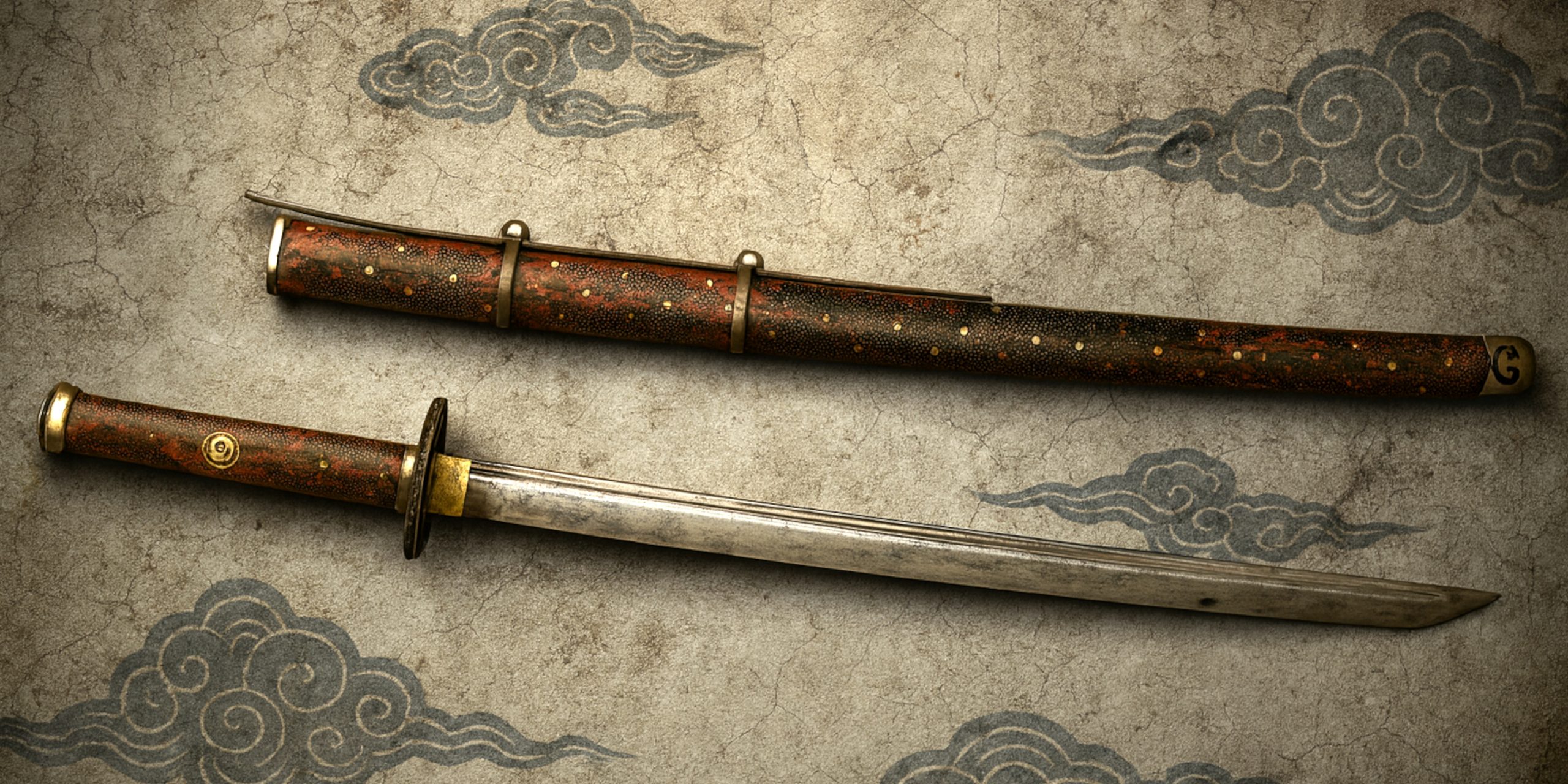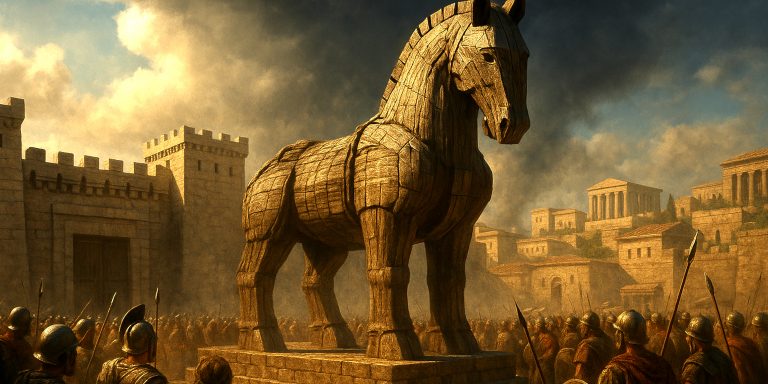
The Chilseong Geom (칠성검), or Seven-Star Sword, is a highly symbolic Korean weapon associated with spiritual protection, royal ceremony, and cosmic alignment. Unlike many practical military swords of the Korean peninsula, the Chilseong Geom bridges the worlds of craftsmanship and mysticism. Its design often features in temples, shrines, and museum displays, linking ancient beliefs in the Big Dipper (Chilseong) to divine guardianship.
While not a battlefield weapon in most cases, it embodies Korea’s philosophical approach to the sword: a fusion of art, ritual, and celestial harmony.
Specifications
| Feature | Description |
|---|---|
| Type | Ritual or ceremonial double-edged sword |
| Origin | Korea (Late Three Kingdoms to Joseon period) |
| Blade Length | Typically 70–90 cm |
| Blade Type | Straight double-edged steel, with inlaid star symbols |
| Hilt | Bronze, brass, or iron with ornate guard and pommel |
| Decoration | Seven dots or star motifs representing the Big Dipper |
| Usage | Ritual, royal ceremonies, temple offerings, spiritual protection |
| Sheath | Often lacquered wood with metal fittings and inscriptions |
The proportions of the Chilseong Geom resemble those of a hwandudaedo or early geom, though the symbolic engravings set it apart.
History and Evolution
The origins of the Chilseong Geom trace to the Three Kingdoms period (57 BC–668 AD), when celestial symbolism began influencing Korean metallurgy and ritual weaponry. The concept of aligning with the stars, particularly the Big Dipper, was linked to fate, longevity, and protection from evil spirits.
- Baekje and Silla eras saw early ritual swords adorned with cosmological motifs, likely used in court rituals and burials.
- By the Goryeo dynasty (918–1392), the Chilseong Geom was integrated into Buddhist ceremonies, symbolising protection by celestial guardians.
- During the Joseon dynasty (1392–1897), Neo-Confucian influence formalised its use in state rituals. The seven-star symbolism also found its way into musok (folk shamanism), blending Confucian and shamanic beliefs.
Over time, it evolved less as a weapon of war and more as a sacred artefact, commissioned by royalty, monks, or temple patrons.
Advantages and Disadvantages
| Advantages | Disadvantages |
|---|---|
| Highly symbolic and spiritually significant | Rarely designed for combat efficiency |
| Exceptional craftsmanship and artistry | Fragile ornamentation limits practical use |
| Valuable to collectors and historians | Authentic examples are scarce and often protected artefacts |
| Unique link to Korean cosmology and royal heritage | Reproductions can vary widely in quality |
The Chilseong Geom’s value lies in its cultural and aesthetic impact rather than battlefield practicality.
Comparison with Similar Weapons
| Weapon | Region | Primary Use | Comparison |
|---|---|---|---|
| Chilseong Geom | Korea | Ritual and symbolic | Embodies celestial symbolism and craftsmanship |
| Seven-Branched Sword (Nanatsusaya no Tachi) | Japan (Baekje origin) | Gifted ceremonial weapon | Shares cosmological and diplomatic roots |
| Dao (Chinese) | China | Military combat | More practical design, less ritual focus |
| Ssangdo (Korean Twin Swords) | Korea | Martial weapon | Functional, contrasting the Chilseong Geom’s ritual nature |
| Hwandudaedo | Korea | Early Korean sword | Physical predecessor, simpler and functional |
The closest analogue is the Seven-Branched Sword presented by Baekje to Japan’s Yamato court in the 4th century, suggesting a shared East Asian cosmological tradition in early sword symbolism.
Legacy
The Chilseong Geom endures as a symbol of divine protection and the connection between heaven and human destiny. Its motifs appear in temple murals, martial art emblems, and even in modern cultural representations of Korea’s royal past.
In contemporary Korea, the sword represents a bridge between martial virtue and spiritual purity. Ceremonial reproductions are still crafted for temple rituals, often engraved with the Big Dipper pattern or Sanskrit characters.
Where to See
| Location | Institution | Notes |
|---|---|---|
| National Museum of Korea (Seoul) | Permanent exhibit | Holds early Joseon ceremonial swords with celestial engravings |
| Gyeongju National Museum | Special collections | Displays ritual weapons from Silla tombs |
| Baekje Cultural Land (Buyeo) | Replica displays | Includes Chilseong Geom reproductions for educational purposes |
| Donghwasa Temple (Daegu) | Religious artefact | Ceremonial use in Buddhist rituals invoking celestial guardians |
Some pieces are held in private royal collections or temple treasuries, occasionally exhibited on loan during cultural heritage festivals.
Collector’s Guide
Rarity:
Authentic Chilseong Geom examples are extremely rare, with most surviving pieces preserved in temples or museums. Collectors generally seek replicas or limited artisan reproductions rather than originals.
Market and Auction Values:
| Type | Estimated Value | Notes |
|---|---|---|
| Authentic Joseon-period ceremonial sword | £30,000–£70,000+ | Museum-grade artefact, rarely sold publicly |
| High-quality 20th-century replica | £1,500–£3,500 | Hand-forged with traditional motifs |
| Modern decorative reproduction | £200–£700 | Commonly found online, often of variable quality |
Buying Tips:
- Seek provenance documentation and maker’s mark if modern.
- Be cautious of mass-produced imports lacking proper inlay detail.
- Korean blacksmiths in Seoul and Gyeongju occasionally produce licensed replicas for collectors.
The Seven Swords Takeaway
The Chilseong Geom remains one of the most enigmatic and spiritual swords in Korean heritage. While never intended for war, it encapsulates the fusion of artistry, ritual, and cosmology that defines Korean sword culture. To hold or even see one is to witness the intersection of star lore, craftsmanship, and devotion, a legacy that continues to shine in both museums and the imagination of historians and collectors alike.



